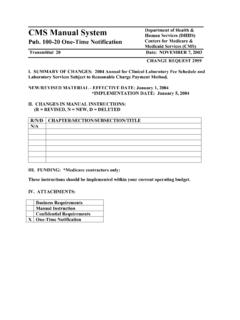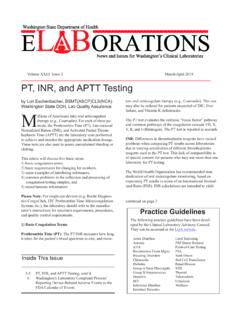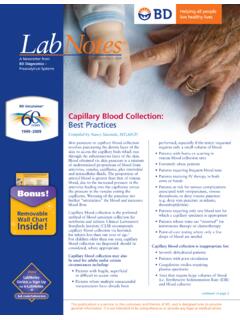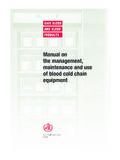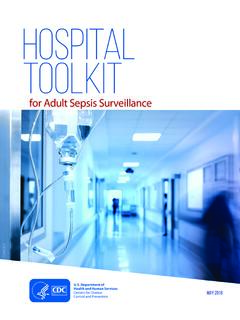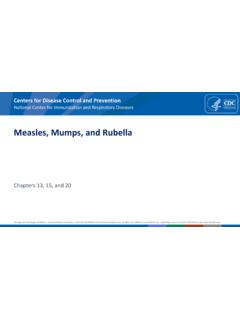Transcription of DRUG NAME: Bortezomib - BC Cancer
1 Bortezomib BC Cancer Drug Manual All rights reserved. Page 1 of 12 Bortezomib This document may not be reproduced in any form without the express written permission of BC Cancer Provincial Pharmacy. Developed: July 2006 Revised: 1 July 2021 DRUG NAME: Bortezomib SYNONYM(S): PS-341; MLN-341 COMMON TRADE NAME(S): VELCADE CLASSIFICATION: miscellaneous Special pediatric considerations are noted when applicable, otherwise adult provisions apply. MECHANISM OF ACTION: Bortezomib is a reversible inhibitor of the 26S proteasome, a protein complex that degrades ubiquitinated proteins. This inhibition affects Cancer cells in a number of ways, including altering regulatory proteins, which control cell cycle progression and Nuclear Factor kappa B activation.
2 Inhibition of the proteasome results in cell cycle arrest and apotosis,1 generally during the G2-M phase of the cell PHARMACOKINETICS: Interpatient variability wide interpatient variability in plasma concentration Distribution distribution half life is less than 10 minutes3 cross blood brain barrier? no information found volume of distribution4 >500 L plasma protein binding no information found Metabolism oxidative deboronation via CYP 3A4 and 2C19; other CYP 450 enzymes (1A2, 2C9, 2D6) have minor roles; Mean AUC values are increased by 60% in moderate to severe liver active metabolite(s) none inactive metabolite(s)3 >30 Excretion urine no information found feces no information found terminal half life 9-15 h clearance no information found Adapted from standard reference1 unless specified otherwise.
3 USES: Primary uses: Other uses: *Multiple myeloma *Lymphoma, non-Hodgkin s *Health Canada approved indication SPECIAL PRECAUTIONS: Contraindications: history of hypersensitivity reaction to boron1 Bortezomib BC Cancer Drug Manual All rights reserved. Page 2 of 12 Bortezomib This document may not be reproduced in any form without the express written permission of BC Cancer Provincial Pharmacy. Developed: July 2006 Revised: 1 July 2021 Caution: Hepatitis B (HBV) reactivation: All lymphoma and myeloma patients should be tested for both HBsAg and HBcAb. If either test is positive, such patients should be treated with lamivudine 100 mg/day orally, for the entire duration of chemotherapy and for six months afterwards.
4 Such patients should also be monitored with frequent liver function tests and HBV DNA at least every two months. If the HBV DNA level rises during this monitoring, management should be reviewed with an appropriate specialist with experience managing hepatitis and consideration given to halting Herpes zoster reactivation may occur; antiviral prophylaxis is suggested for all An increased risk of peripheral neuropathy may occur when Bortezomib is used concomitantly with other drugs associated with peripheral neuropathy; ( , amiodarone, antiviral agents, isoniazid, nitrofurantoin, and HMG-CoA reductase inhibitors.)10 Overdosage with as little as twice the recommended dose has been associated with the acute onset of symptomatic hypotension and thrombocytopenia with fatal In the event of an overdosage, monitor vital signs and provide supportive care to maintain blood pressure and body Special Populations: Greater sensitivity of elderly patients cannot be ruled out; however, no overall differences in safety or effectiveness were observed between younger patients and patients >65 years of Patients on oral antidiabetic agents receiving Bortezomib may experience either hypo- or hyperglycemia.
5 Monitor blood glucose levels Dose adjustment of oral hypoglycemics may be Patients with amyloidosis should be treated with caution as the impact of proteasome inhibition on disorders associated with protein accumulation is An increased risk of hypotension exists when Bortezomib is used with medications that can cause Dosage adjustment of hypotensive agents may be Potentially life-threatening transfusion-related graft-versus-host-disease can occur in previously treated myeloma patients. Patients receiving Bortezomib for myeloma should receive irradiated blood products, effectively eliminating this risk. Carcinogenicity: no information found Mutagenicity: Not mutagenic in Ames test and in the mammalian in vivo mutation test.
6 Bortezomib is clastogenic in mammalian in vitro chromosome Fertility: Fertility studies have not been performed. Degenerative effects in ovaries and testes suggest a potential effect on Pregnancy: FDA Pregnancy Category There is positive evidence of human fetal risk, but the benefits from use in pregnant women may be acceptable despite the risk ( , if the drug is needed in a life-threatening situation or for a serious disease for which safer drugs cannot be used or are ineffective). Breastfeeding is not recommended due to the potential secretion into breast SIDE EFFECTS: The table includes adverse events that presented during drug treatment but may not necessarily have a causal relationship with the drug. Because clinical trials are conducted under very specific conditions, the adverse event rates observed may not reflect the rates observed in clinical practice.
7 Adverse events are generally included if they were reported in more than 1% of patients in the product monograph or pivotal trials, and/or determined to be clinically When placebo-controlled trials are available, adverse events are included if the incidence is > 5% higher in the treatment Bortezomib BC Cancer Drug Manual All rights reserved. Page 3 of 12 Bortezomib This document may not be reproduced in any form without the express written permission of BC Cancer Provincial Pharmacy. Developed: July 2006 Revised: 1 July 2021 ORGAN SITE SIDE EFFECT Clinically important side effects are in bold, italics allergy/immunology hypersensitivity reactions (<1%) cutaneous vasculitis17-19 blood/bone marrow/ febrile neutropenia anemia (26-32%, severe 9-10%) neutropenia (19-24%, severe 14-16%) thrombocytopenia1 (35-43%, severe 30%); nadir day 11; see paragraph following Side Effects table auditory/hearing hearing loss (<1%)20 cardiovascular (arrhythmia) arrhythmias (<1%) cardiovascular (general) congestive heart failure; decreased left ventricular ejection fraction (<1%) hypotension (11-12%, severe 4%).
8 See paragraph following Side Effects table ischemia, infarction, angina (<1%) pulmonary hypertension (<1%) coagulation disseminated intravascular coagulation (<1%) constitutional symptoms fatigue21 (61-65%, severe 12-18%) fever (35-36%, severe 4-6%) insomnia (18%) rigors (11-12%) dermatology/skin extravasation hazard: irritant1 pruritis (12%) rash, urticaria22 (24-28%, severe 2%) endocrine ADH secretion abnormalities (<1%) gastrointestinal emetogenic potential: rare12,23 anorexia (34-43%, severe 2-3%) constipation1 (42-43%, severe 2%) dehydration1 (18%, severe 7%) diarrhea1 (55-58%, severe 7-8%); see paragraph following Side Effects table dyspepsia (10-13%) enteritis (<1%)24 ileus, obstruction (<1%) nausea1 (57-64%, severe 2-7%) stomatitis (<1%) taste alterations, dysgeusia (13%) vomiting1 (35-36%, severe 3-7%) hemorrhage epistaxis (10%) Bortezomib BC Cancer Drug Manual All rights reserved.
9 Page 4 of 12 Bortezomib This document may not be reproduced in any form without the express written permission of BC Cancer Provincial Pharmacy. Developed: July 2006 Revised: 1 July 2021 ORGAN SITE SIDE EFFECT Clinically important side effects are in bold, italics severe hemorrhage (<1%) hepatobiliary/pancreas liver failure (<1%)25; see paragraph following Side Effects table acute pancreatitis (<1%) infection febrile neutropenia (<1%)21 herpes zoster (11-13%, severe 1%) nasopharyngitis (14%) pneumonia (10%, severe 5%) sepsis (<1%) upper respiratory tract infection (18%) lymphatics peripheral edema (17-21%, severe 1%) metabolic/laboratory asymptomatic increases in liver enzymes (<1%) electrolyte abnormalities (<1%) hyperbilirubinemia (<1%) hyperuricemia; during periods of active cell lysis (<1%).
10 See paragraph following Side Effects table musculoskeletal arthralgia (15-28%, severe 5%) muscle cramps (24%) neurology dizziness excluding vertigo (14-21%, severe 1%) encephalopathy (<1%) headache (28%, severe 4%) insomnia (18-27%, severe 1%) hypoesthesia (11%) mood alterations, anxiety (14%) peripheral neuropathy21 (36-37%, severe 8-14%); see paragraph following Side Effects table psychosis (<1%) seizures (<1%) sensory neuropathy, paresthesias (14-21%, severe 2%) ocular/visual blurred vision (11%, severe 1%) diplopia (<1%) pain abdominal pain (16-20%, severe 2%) back pain (14%, severe 3-4%) bone pain (16-17%, severe 4-5%) limb pain (15%, severe 2%) musculoskeletal pain (10%) Bortezomib BC Cancer Drug Manual All rights reserved.










